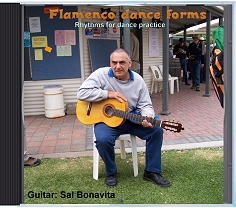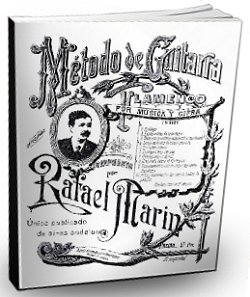Continuous rasgueados
3 exercises to improve continuous rasgueados
Exercise 1
Here is a little tip to help break away from accenting the same finger every time during rasgueados. It's a good mental discipline to help make them sound smoother and truly continuous. When you practice a continuous rasgueado the fingers naturally will want to play the some accent each time in the cycle. For example, if you play e a m i continuously, the accent tends to always fall on the "e" finger. This is ok if that's the effect you want, but it gets annoying if you just want a continuous flow of strokes without accents.
When you play a continuous rasgueado you should be aiming to get a clean, continuous series of strokes with no accents breaking up the flow of sound. For example, the last thing you want to hear when you play a 4 stroke pattern is
ONE two three four ONE two three four
This sounds choppy and defeats the purpose of trying to get a smooth, continuous sound. When you practice 4 stoke rasgueados, count in threes so you accent in cycles of three instead of four. With e m a i, The accents would be
E a m - I e a - M i e - A m i - E a m - I e a .....etc
As you proceed through this exercise, the starting finger accent will not be the focus and therefore will not be the dominant feature. The idea is to make all the finger strokes sound equally loud (of soft). This is another training exercise to break up old habits and develop a muscle memory in the fingers. So you would be counting like this.
1 2 3 - 4 1 2 - 3 4 1 - 2 3 4 - 1 2 3 - 4 1 2.....etc
Of course exactly the same principle applies if you are practicing the i e a m 4 stroke rasgueado.
Exercise 2
Do the same thing with 5 stroke rasgueados. Count in accent cycles of four.
For Example, lets say you were practicing the five stroke e a m i i

In this case the starting accent is on e. Here are two ways to practice this 5 stroke rasgueado to prevent the accent always falling on e.
1) Practice in 3s
E a m - I i e - A m i - I e a - M i i - E a m - I i e .....etc
2) Practice in 4s
E a m i - I e a m - I i e a - M i i e - A m i i .....etc
Exercise 3
Do the same thing with 3 stroke rasgueados. Count in cycles of four or five. It doesn't matter which as long as it's different. Try the PmP triplet rasgueado. I started out practicing this in 4s as an exercise to make it smoother. Then I realized that playing it in fours and deliberately accenting the first count of every four produced a dramatically different sound which I liked. I use this "triplet in fours" a lot now. You can hear an example of this at the end of the granadinas video.

P m p p - M p p m - P p m p - P m p p - M p .....etc
These are all just guidelines to give you some ideas for practice. Try other combinations like 6s. Be creative. I have found that dreaming up different ways to practice something takes the edge off what would otherwise be a boring and tedious practice session. Being creative is not restricted to rasgueado practice. Try changing your practice studies and exercises to make them more interesting. The main reason I came up with the different ways to play Romance was not to show the world how clever I was. I basically got bored with playing it the same old way with standard arpeggios.
In short, I wanted to master the stretches and barre chords in this piece but I didn't want to bore myself silly in the process. The tremolo and ragtime versions of Romance have received more views and comments on You Tube than any of my other videos. And yet they both started out as simple exercises that were based on the principles outlined in this lesson. Practice time does not have to be a chore. Be creative and practice sessions will turn into daily events you will look forward to. Have fun with it.
|
Quick jump Part 1 - Things you need to know Part 2 - The 6 part master key Part 3 - Continuous rasgueados Part 4 - Common rasgueado patterns |





